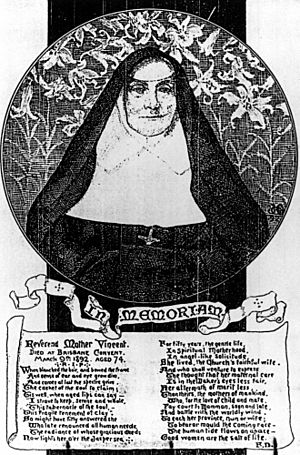Mother Vincent Whitty facts for kids
Mother Mary Vincent Whitty (born Ellen Whitty, 1819–1892) was an Irish religious sister. She is famous for her important work in the early days of the Queensland colony in Australia. She played a big role in the Institute of the Sisters of Mercy, both in Ireland and as they grew in Australia.
Contents
Early Life in Ireland
Ellen Whitty was born on March 3, 1819, in a small village called Pouldarrig, near Wexford, Ireland. She was one of six children born to William and Johanna Whitty.
Her family was very religious. One of her sisters, Mary Agnes, also became a Sister of Mercy. Her brother, Robert Whitty, became a leader of the Jesuits in Great Britain.
Joining the Sisters of Mercy
In 1839, when she was 19, Ellen Whitty joined the Sisters of Mercy in Dublin, Ireland. She was taught by Catherine McAuley, who was the founder of the Sisters of Mercy. Catherine McAuley was very close to Ellen. She even asked Ellen to be by her side during her final hours.
Ellen became known as Sister Mary Vincent Whitty. She quickly showed great skill in leadership. In 1844, she became the Mistress of novices. This meant she trained new sisters. By 1849, she was chosen as the Superior General of the whole group. She was the third leader after Catherine McAuley.
Helping During the Crimean War
While Mother Vincent was in charge, the Crimean War was happening. She offered the help of the Sisters of Mercy to care for sick and wounded soldiers. Her own sister, Mary Agnes, was one of the sisters who went to help during the war.
Building and Growing the Order
Mother Vincent Whitty was very good at organizing. She helped plan the Mater Hospital in Dublin. She also started five new convents, which are places where sisters live and work. She set up three places in Dublin to help children and women who needed support.
Moving to Queensland, Australia
Mother Vincent's skills were so valuable that the Sisters of Mercy in Ireland did not want her to leave. However, Bishop James Quinn asked her to come to Australia. He had just been named the first Bishop of Brisbane in the new colony of Queensland.
Queensland was a huge area, as big as France, Spain, and Italy combined. At that time, it had only two priests and four churches. Bishop Quinn wanted Mother Vincent and five other Sisters to be the first women religious in his new diocese.
Even though her community was sad to see her go, Mother Vincent was ordered by Archbishop Cullen to lead this mission. She was appointed as the Superior of the group.
Starting a New Life in Brisbane
Mother Vincent Whitty arrived in Brisbane with five other Sisters on May 10, 1861. They quickly began their work. In November of that same year, they founded All Hallows' School. This was a Catholic school for girls.
Even though the bishop removed her as Superior in 1863, Mother Vincent's work continued to grow. The community of Sisters she started spread quickly throughout the new colony. Before she died, they had founded more than 20 convents.
Bishop Quinn's choice to bring Mother Vincent to Queensland was very important. Under her leadership, the Sisters of Mercy helped the Catholic community grow and develop across Queensland.
Later Life and Legacy
Mother Mary Vincent Whitty passed away on March 9, 1892, at All Hallows' Convent in Brisbane. She had been ill with bronchitis. Her funeral was held at the Cathedral of St Stephen, Brisbane. She was buried in the Nudgee Catholic Cemetery.
Her Lasting Impact
Mother Vincent Whitty left behind a strong legacy. At the time of her death, there were 222 Sisters in Queensland. They ran 26 schools with 7,000 students. They also managed welfare places that cared for about 200 children. A training college for teachers was also set up at Nudgee.
The Sisters of Mercy in Brisbane became their own group, following the traditions of Catherine McAuley. A street in Canberra, Australia's capital, was named after Mother Vincent Whitty. This was done to honor her important work in Australian education. Her influence on education in Queensland was also the subject of a university study in 1969.
Images for kids



